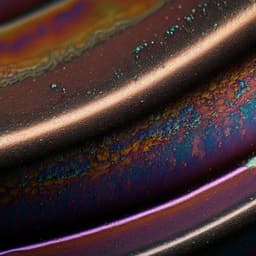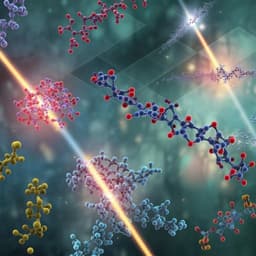
Engineering and Technology
Starch-mediated colloidal chemistry for highly reversible zinc-based polyiodide redox flow batteries
Z. Wei, Z. Huang, et al.
Discover the breakthrough in aqueous Zn-I flow batteries, developed by Zhiquan Wei and colleagues, featuring innovative iodine-starch catholytes that dramatically enhance performance and efficiency. With impressive power density, high Coulombic efficiency, and significant cost reduction, this research paves the way for sustainable energy storage solutions.
~3 min • Beginner • English
Introduction
The study addresses the central challenge in zinc–iodine (Zn-I) redox flow batteries: polyiodide (Ix−) crossover through membranes, which causes capacity loss and low Coulombic efficiency. Conventional dense, fluorinated Nafion membranes provide better selectivity but at high cost and with increased resistance that reduces voltage and energy efficiency, especially at high current densities, limiting power density. Low-cost polyolefin-based porous membranes (LPPM), such as polypropylene (PP), offer high ionic conductivity and low resistance, enabling high current operation, but suffer from poor selectivity and severe active species crossover, exacerbated at elevated temperatures in outdoor renewable integrations. The hypothesis is that increasing the effective size of iodine redox species via colloidal chemistry (iodine–starch complexes) can leverage the size-sieving effect of porous membranes to suppress crossover while maintaining high ionic conductivity, thereby enabling low-cost, high-power Zn-I flow batteries operable even at high temperatures.
Literature Review
Prior work emphasizes the trade-off between membrane selectivity and conductivity in flow batteries. Nafion-based membranes are widely used but expensive and resistive at high currents, limiting power density. Strategies including new polymer membranes, functional coatings, and electrolyte regulation have been explored, but precise pore-size tuning, controlled thickness, and charge-state engineering pose challenges and costs. Low-cost polyolefin porous membranes provide low ionic resistance but allow significant polyiodide crossover and capacity fading, particularly at elevated temperature and under intermittent renewable operation. Coating LPPM to add ion sieving or charge repulsion can reduce crossover but increases ionic resistance and adds synthesis complexity and cost. The literature indicates that iodine redox couples (I−/I3−/I5−) provide high theoretical capacity and safety, but managing polyiodide shuttling is crucial. Strong interactions between starch (amylose) and iodine are known to form complexes; leveraging this interaction to tune active species size for membrane size-exclusion in redox flow systems had not been developed prior to this work.
Methodology
- Colloidal catholyte design: Prepared iodine–starch (IS) colloidal electrolytes by dissolving soluble amylose starch (up to 3 M) with ZnI2 (fixed at 2 M) in water. Identified optimal starch concentration balancing viscosity, conductivity, and permeability.
- Physicochemical characterization: Assessed Tyndall effect to confirm colloidal nature. Measured viscosity and ionic conductivity versus starch concentration (0–3 M). Evaluated I3− permeability using two-compartment H-cell across PP membranes by UV-Vis (288 and 350 nm I3− peaks), extracting permeability. Determined particle sizes by AFM for starch and starch/polyiodide colloids; compared with PP membrane pore size (≈37.28 nm) to assess size-sieving. Raman spectroscopy across states of charge (SOCs) to track I3− and I5− species; XPS (I 3d) to corroborate species stabilization.
- Computational analysis: DFT (B3LYP/def2-TZVP with D3 dispersion, SMD solvent) calculated binding energies for starch complexes with I, I3−, I5−, Zn2+, and Cl−; ESP mapping identified electron-rich hydroxyl regions as binding sites. Cation transference numbers (t+) measured for ZnI2 and ZnCl2 with/without starch to infer anion trapping.
- Electrochemical testing: Assembled 2 × 2 cm2 Zn-I flow cells with CF electrodes, PP (Celgard) or Nafion N117 membranes, catholyte 2 ml 2 M ZnI2 with 1 M starch, anolyte 8 ml 2 M ZnCl2. Performed rate studies at 7.5–37.5 mA cm−2, measuring CE, VE, EE and power density. Conducted EIS (AC, 10 mV, 1 MHz–0.1 Hz), DC polarization for internal resistance, CV/CA to probe electrode coverage and kinetics. Cycling tests at high current (30 mA cm−2) and high volumetric capacity (≈33.5–36 Ah L−1, 50% SOC) at 25 °C and 50 °C. Asymmetric Zn plating/stripping cells assessed anode reversibility and CE with/without starch.
- Scale-up and renewable integration: Built 25 cm2 single cell, integrated with photovoltaic modules via a DC-DC boost converter; recorded solar intensity and charging current over a day; discharged to evaluate capacity and energy delivery; demonstrated LED lighting.
- Cost modeling: Estimated installed costs for 1-MW stacks using measured sustained power densities at 22.5 mA cm−2 for PP with starch (≈26.55 mW cm−2) and Nafion-based (≈19.95 mW cm−2). Calculated required membrane areas (PP 3766 m2 vs N117 5012 m2) and total installed costs using membrane unit prices ($10/m2 PP, $500/m2 N117) and component BOM from Supplementary data.
Key Findings
- Colloid formation and size control: Starch solutions exhibit a Tyndall effect; in 1 M starch, colloidal particle size ≈78.56 nm; with polyiodide at 50% SOC, colloid size increases to ≈138.49 nm, exceeding PP membrane pore size (~37.28 nm), enabling size-sieving.
- Transport properties: Increasing starch concentration (0→3 M) raises viscosity sharply (e.g., 1 M: 13.5×10−3 Pa·s; 3 M: 1570×10−3 Pa·s) and decreases ionic conductivity (from 100.1 to 6.5 mS cm−1). 1 M starch maintains favorable conductivity. I3− permeability across PP drops substantially with starch, indicating effective iodine confinement.
- Species stabilization and interactions: Raman shows stable I3− and I5− signals with blue shifts upon charging in starch-containing electrolytes; XPS confirms dominant I5− at 50% SOC with starch. DFT binding energies (more negative is stronger): starch@I (−0.354 eV) > starch@Cl (−0.119 eV) > starch@Zn2+ (−0.081 eV); long-chain starch binds I5− (−0.66 eV) more strongly than I3− (−0.51 eV). ZnI2 electrolyte t+ increases from 0.484 to 0.651 with starch, consistent with anion entrapment.
- Room-temperature electrochemistry (PP membrane, 2 ml 2 M ZnI2 + 1 M starch || 8 ml 2 M ZnCl2): CE–VE–EE at 7.5/15/22.5/30/37.5 mA cm−2 are approximately 94–91–86%, 96–85–83%, 98–81–78%, 98.5–75–74%, 98.6–70–70%, respectively; EE recovers upon returning to 7.5 mA cm−2. Peak power density ≈41.58 mW cm−2 (vs 28.41 mW cm−2 for Nafion N117 without starch). Lower impedance and internal resistance with PP+starch than N117.
- Cycling stability: At 30 mA cm−2, stable over 350 cycles with CE ≈98.5% and volumetric capacity ≈6 Ah L−1(catholyte). At high volumetric capacity (~33.5 Ah L−1, 50% SOC), >250 cycles with CE >95% at 22.5 mA cm−2. Without starch on PP, CE ~65%, severe capacity loss, and ≤50 cycles.
- High-temperature (50 °C) operation: Rate performance maintains high CE (92–98%) and EE (70–84%) across 7.5–37.5 mA cm−2; peak power ≈70.12 mW cm−2. At 30 mA cm−2, CE ≈98.9% with stable cycling. At ~35.5 Ah L−1 charge, 200 cycles with CE ~91% and discharge capacity ≈32.4 Ah L−1; without starch, CE <40% and ~18 Ah L−1 capacity under same conditions.
- Anode behavior: Asymmetric Zn plating/stripping with starch shows >240 h (≈340 cycles) with CE 99.01% at 30 mA cm−2, 10 mAh cm−2, outperforming blank electrolyte (~150 h, CE 98.23%). Starch mitigates pH rise and suppresses by-products (Zn5(OH)6Cl2·H2O, ZnO) and dendrites.
- Practical demonstration: 25 cm2 cell integrated with PV; daytime charging currents tracked solar intensity; delivered 0.496 Ah and 0.535 Wh at 20 mA cm−2; powered 280-LED “Energy” logo outdoors with ambient ground temperature up to ~45.8 °C.
- Cost analysis (1-MW stack): Required membrane area: N117 5012 m2 vs PP 3766 m2. Installed cost: N117 ≈$1,970,000 (membrane 88.49% at $500/m2) vs PP ≈$280,000 (membrane 13.32% at $10/m2), a ~90% reduction (~14.3× lower). For a 1 MWh long-duration system, total stack cost lower for PP-based Zn-IS ($636,013) vs N117-based ($3,184,189).
Discussion
The results validate that starch-mediated colloidal chemistry enlarges the effective size of active iodine species and stabilizes polyiodides (I3−/I5−) through strong chemisorption, enabling size exclusion by inexpensive porous PP membranes. This suppresses polyiodide crossover without sacrificing ionic conductivity, thereby improving Coulombic efficiency and power density relative to dense Nafion membranes. Enhanced cation transference and reduced internal resistance facilitate high-rate performance. Colloidal starch also moderates anode-side reactions by stabilizing electrolyte pH, reducing dendrite formation and by-products, which further contributes to cycling stability. The approach maintains efficacy at elevated temperatures (50 °C), addressing practical challenges for outdoor renewable integration. Scalability is demonstrated through a larger-area cell charged by photovoltaics and through cost analyses projecting substantial installed-cost reductions driven by low-cost membranes and higher sustained power. Overall, the colloidal electrolyte strategy directly addresses the crossover problem while improving system-level metrics important for grid-scale deployment.
Conclusion
This work introduces a colloidal catholyte strategy using renewable, low-cost soluble starch to form iodine–starch aggregates that match porous PP membrane pore sizes, suppressing polyiodide crossover while preserving high ionic conductivity. The Zn-IS flow batteries achieve high-rate performance (up to 37.5 mA cm−2), high power density (~42 mW cm−2 at room temperature; ~70 mW cm−2 at 50 °C), high CE (≈98%+), and long cycling life (≥350 cycles at high current; ≥200–250 cycles at high volumetric capacity and 50 °C). The method also improves Zn anode reversibility by mitigating side reactions. Cost modeling for a 1-MW stack indicates a dramatic installed-cost reduction enabled by PP membranes. Future work could optimize colloid size/composition, membrane–electrolyte matching, and stack engineering to further enhance energy density, durability, and cost effectiveness under diverse operating conditions.
Limitations
- Electrolyte viscosity increases sharply with starch concentration, reducing ionic conductivity; thus, performance depends on carefully optimizing starch content (1 M identified as a balance). Excessive colloid size may impair diffusion or cause precipitation.
- Initial high-temperature cycling showed CE variations attributed to air oxidation of I− and undissolved Zn contributing in later cycles, indicating sensitivity to environmental conditions and thermal effects on Zn dissolution.
- Some ultrasmall starch particles can migrate to the anolyte; while beneficial here for stabilizing pH, such crossover could be system-dependent and may require control in different designs.
- Results are demonstrated with specific PP membrane pore size (~37 nm) and selected electrolyte compositions; generalization to other porous separators or different operating regimes may require re-optimization of colloid size and concentration.
Related Publications
Explore these studies to deepen your understanding of the subject.







